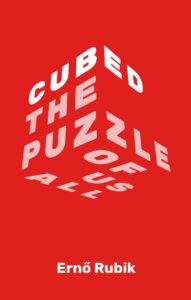
Question More, Action Knowledge.
Remember, at QMAK, we don’t just teach; we empower. We don’t just inform; we inspire. We don’t just question; we act. Become a Gold Member, and let’s unlock your child’s full potential, one question at a time.
 The Rubik’s Cube, an iconic symbol of the 1980s and a timeless emblem of problem-solving, has captivated generations with its colorful, twisting charm.
The Rubik’s Cube, an iconic symbol of the 1980s and a timeless emblem of problem-solving, has captivated generations with its colorful, twisting charm.
Invented by Hungarian architect Ernő Rubik in 1974, this three-dimensional puzzle has become more than just a toy; it’s a global phenomenon that has inspired countless individuals to embrace their creativity and entrepreneurial spirit.
As homeschooling parents and educators, we can learn valuable lessons from the Rubik’s Cube and its creator. Rubik’s journey is a testament to the power of curiosity and the importance of pursuing one’s passions. In his autobiographical account “Cubed,” Rubik emphasizes the role of curiosity in his creative process: “I was just tremendously curious. I wanted to find something out. Even if I didn’t know exactly what that something was.”
This innate curiosity drove Rubik to create the first prototype of the Cube in the spring of 1974. He submitted a patent application for his “three-dimensional logical toy” on January 30, 1975, and by 1977, small-scale production had begun in Hungary. The Cube’s popularity soared after it won a prize at the Budapest International Trade Fair in 1978, and by the early 1980s, it had become a global craze.
The Rubik’s Cube’s success story is a reminder that great ideas can come from unexpected places. Rubik, an architect by training, never set out to create a bestselling toy. His passion for geometry and understanding the underlying structure of things led him to create a puzzle that has stood the test of time. As Rubik reflects, “Puzzles are not just entertainment or devices for killing time. For us, as for our ancestors, they help point the way to our creative potential.”
Incorporating puzzles into our homeschooling curriculum can help foster this same sense of creativity and problem-solving in our children. The Rubik’s Cube, with its 43 quintillion possible configurations, is a perfect example of how a seemingly simple concept can lead to complex challenges and endless possibilities. As Rubik notes, “It has often been observed that finding the solution to a puzzle is a kind of microcosm, a model for problem-solving in other parts of our lives.”
Beyond its problem-solving potential, the Rubik’s Cube has also had a profound cultural impact. It has appeared in art exhibitions, been featured in music videos, and even used in advertising and political commentary. This multifaceted impact demonstrates the power of a well-designed, functional object to transcend its original purpose and become a cultural icon.
For homeschooling families, the Rubik’s Cube’s journey can also serve as an inspiration for entrepreneurship. Rubik’s story shows that with dedication, passion, and a bit of luck, a simple idea can turn into a global phenomenon. As Rubik reflects on the Cube’s success, he remains grounded, emphasizing the importance of personal fulfillment over financial gain: “Our attitude toward money is characteristic of each of us. . . . If one accepts that money is the best way for measuring the value of things, it can easily become a compass for finding one’s way in the world. This is rather convenient. But it is dangerous and misleading.”
At QMAK, we understand the value of incorporating puzzles and creative problem-solving into our educational approach. By embracing the lessons of the Rubik’s Cube and its inventor, we aim to inspire our students to pursue their curiosity, develop their creativity, and approach challenges with a systematic, entrepreneurial mindset.
So, the next time you or your child picks up a Rubik’s Cube, remember that you’re holding more than just a colorful puzzle; you’re holding a symbol of creativity, perseverance, and the power of the human mind to overcome even the most daunting challenges.

Remember, at QMAK, we don’t just teach; we empower. We don’t just inform; we inspire. We don’t just question; we act. Become a Gold Member, and let’s unlock your child’s full potential, one question at a time.